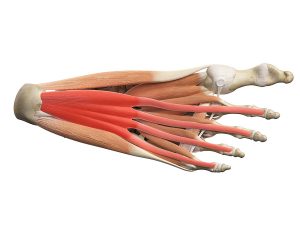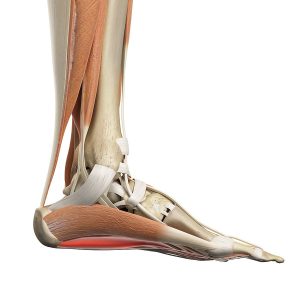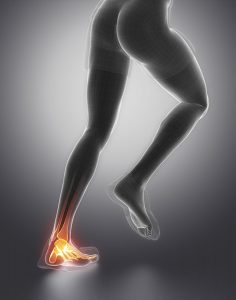Plantar Fasciitis is inflammation of connective tissue in the sole of your arch in your foot. It’s curable and treatable, but there’s a few things you need to know before you go rolling your foot on an ice bottle. Understanding the triggers and causes that make it worse can significantly improve your healing time. We provide Plantar Fasciitis treatment that works.
Inflammation of the plantar fascia may happen when you suddenly change your activities. If you increase your walking distance (like when you want to reach your step count), take up running or change your shoes. This new load can cause micro tears in the plantar fascia, usually at the insertion of the heel. These small tears then become inflamed as your body attempts to heal them. If you continue with the aggravating activities, more of the fascia tears, causing more inflammation.

What is the Plantar Fascia?
The plantar fascia is a thick band of connective tissue underneath your foot. It is made up of tendons that spread from the heel bone, along the arch, towards your toes. These structures support your foot’s arch. It acts as a shock absorber as your feet carry your weight when you stand or walk.
Due to the high pressure placed on this web of connective tissue by every day demands, excessive walking, prolonged standing and poor support from shoes, the plantar fascia can become inflamed. The inflammation of these structures is called plantar fasciitis.
Causes of Plantar Fasciitis
Plantar fasciitis develops due to repetitive or prolonged activities that place strain on the plantar fascia. The arch of the foot is three dimensional. It is formed by (1) the bones in the foot (metatarsals), from the ankle to the toes. (2) The medial arch (on the inside of the foot) runs from the inner heel to the big toe. This is the arch that is decreased if you have “flat feet”. Then you have (3) a lateral arch (on the outside of the foot) that runs from the outer heal to the little toe. The transverse arch connects the medial and lateral arches from the big toe to the little toe. The plantar fascia supports these three arches, like a dome from below.
You are at greater risk to develop plantar fasciitis if you are on your feet for long hours or walk long distances. People who work in health care (nurses), construction and sales especially. Sports that involve repetitive stress to the bottom of the foot on hard surfaces, like hockey, cricket, hiking and marathon running, can also cause plantar fasciitis. Long-distance runners and dancers are more prone to develop plantar fasciitis due to the excessive range of movement that is needed during these activities. Tight calf muscles cause more load through the plantar fascia and may lead to inflammation. Unsuitable shoes that do not cushion the foot sufficiently, or support the arch, or place the fascia in a stretched position (all heels, ladies!) are one of the main factors that lead to plantar fasciitis.
In some cases the pain may develop suddenly due to a high force going through the plantar fascia like a sudden push off out of the starting blocks or falling from a height and landing on your feet. Mostly the inflammation builds up because of repetitive strain. Being overweight or a sudden increase in weight (training or pregnancy) increases the tension on the plantar fascia and may lead to inflammation.
Symptoms of Plantar Fasciitis
Plantar fasciitis causes pain on the bottom of the heel. This pain is severe in the morning, when you take that first step out of bed. Pain may stop during exercise and return afterwards. You will feel pain after resting when you place weight through the foot again.
- Stiffness or dull burning ache (like a cramp)
- Pain underneath the heel along the arch of the foot
- Stiffness over the arch of the foot that increases with rest (typically in the morning or after sitting)
- Pain during activities like walking, running, sprinting, jumping or landing
Mild
Moderate
Dangerous
During the initial stages
You will feel stiffness over the arch of the foot with minimal pain. As time goes by the pain will focus on the bottom of the heel. The stiffness will ease with movement, only to come back after rest. Common phrases we hear our patients say:
“The pain is only there when I start running, then it goes away but afterwards the stiffness comes back.”
“When I’ve been working and sitting for a few hours, that first few steps is the worst and then it gets better as I walk around.”
When it gets worse
Stiffness and pain in the foot that takes longer to ease, is a tell tale sign of worsening inflammation in the plantar fascia. The pain can be so severe that you are unable to put weight on the foot, and walk with a limp. You may also experience swelling and tenderness when touching the inner aspect of your heel. Stretching the calf muscles may also produce a sharp pain that radiates into the shin or calf.

Heel spurs & Plantar Fasciitis
Excessive and continuous load through the plantar fascia can lead to calcium deposits on the calcaneus (heel bone). These heel spurs occur where the heel bone is irritated at the spot where tendon of the plantar fascia attaches to the heel bone. This can be diagnosed with X rays.
Diagnosis
Physiotherapists are trained to examine the structures of the foot, including the bone, ligaments and tendons. We will be able to guide you if further investigations are necessary. X-rays enable us to see the bony structures of the foot, and a heel spur can be diagnosed this way. The plantar fascia is soft tissue and can be visualized with an ultrasound (sonar). The ultrasound will show thickening and damage to the the structures.
Risks and complications
If left untreated plantar fasciitis will usually worsen. You may experience severe pain when placing weight on your foot. This can then lead to limping, in an attempt to reduce the weight you take on the foot. Limping can then influence your ankle, knee, hip and eventually your back too.
Recovery time
Plantar fasciitis should heal within 3 months with treatment. If you have surgery, you should wait three to six months before returning to sport.
If you think you may have Plantar Fasciitis you should:
- Stop aggravating activities (walking/standing/jogging)
- Use ice and rest to reduce the inflammation
- Call us to set up an appointment to confirm the diagnosis and guide you through a rehabilitation program
Physiotherapy treatment for Plantar Fasciitis
Early stage
- Electrotherapy to reduce local inflammation (ultrasound/LASER/TENS)
- Soft tissue mobilisation to relieve your symptoms (myofascial release/dry needling)
- Immobilization with strapping or taping
- Night splints can be warn to reduce morning stiffness
- Orthotics (insoles) may be necessary
- Specific exercises and ice application at home
You may begin:
- Deep water pool running to maintain your cardiovascular fitness

If your Plantar Fasciitis fails to respond to physiotherapy treatment
Your GP can prescribe medications to alleviate your pain and reduce inflammation.
We may refer you to a specialist for injection directly into the tendon.
If your plantar fasciitis symptoms persist for 12 months, as a last resort, we will recommend surgery to relieve tension and information from the plantar fascia.

